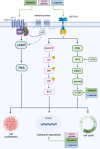The effect of GLP-1R agonists on the medical triad of obesity, diabetes, and cancer
- PMID: 38801466
- PMCID: PMC11554930
- DOI: 10.1007/s10555-024-10192-9
The effect of GLP-1R agonists on the medical triad of obesity, diabetes, and cancer
Abstract
Glucagon-like peptide-1 receptor (GLP-1R) agonists have garnered significant attention for their therapeutic potential in addressing the interconnected health challenges of diabetes, obesity, and cancer. The role of GLP-1R in type 2 diabetes mellitus (T2DM) is highlighted, emphasizing its pivotal contribution to glucose homeostasis, promoting β-cell proliferation, and facilitating insulin release. GLP-1R agonists have effectively managed obesity by reducing hunger, moderating food intake, and regulating body weight. Beyond diabetes and obesity, GLP-1R agonists exhibit a multifaceted impact on cancer progression across various malignancies. The mechanisms underlying these effects involve the modulation of signaling pathways associated with cell growth, survival, and metabolism. However, the current literature reveals a lack of in vivo studies on specific GLP-1R agonists such as semaglutide, necessitating further research to elucidate its precise mechanisms and effects, particularly in cancer. While other GLP-1R agonists have shown promising outcomes in mitigating cancer progression, the association between some GLP-1R agonists and an increased risk of cancer remains a topic requiring more profound investigation. This calls for more extensive research to unravel the intricate relationships between the GLP-1R agonist and different cancers, providing valuable insights for clinicians and researchers alike.
Keywords: Cancer; Diabetes; GLP1RA; Obesity; Ozempic; Semaglutide.
© 2024. The Author(s).
Conflict of interest statement
Figures




Similar articles
-
Cardiovascular Actions and Clinical Outcomes With Glucagon-Like Peptide-1 Receptor Agonists and Dipeptidyl Peptidase-4 Inhibitors.Circulation. 2017 Aug 29;136(9):849-870. doi: 10.1161/CIRCULATIONAHA.117.028136. Circulation. 2017. PMID: 28847797 Review.
-
The dual GCGR/GLP-1R agonist survodutide: Biomarkers and pharmacological profiling for clinical candidate selection.Diabetes Obes Metab. 2024 Jun;26(6):2368-2378. doi: 10.1111/dom.15551. Epub 2024 Apr 1. Diabetes Obes Metab. 2024. PMID: 38560764
-
Glucagon agonism in the treatment of metabolic diseases including type 2 diabetes mellitus and obesity.Diabetes Obes Metab. 2024 Sep;26(9):3501-3512. doi: 10.1111/dom.15693. Epub 2024 Jun 9. Diabetes Obes Metab. 2024. PMID: 38853300 Review.
-
Running on mixed fuel-dual agonistic approach of GLP-1 and GCG receptors leads to beneficial impact on body weight and blood glucose control: A comparative study between mice and non-human primates.Diabetes Obes Metab. 2018 Aug;20(8):1836-1851. doi: 10.1111/dom.13212. Epub 2018 Jun 25. Diabetes Obes Metab. 2018. PMID: 29938884 Free PMC article.
-
Team Players or Opponents: Coadministration of Selective Glucagon and GLP-1 Receptor Agonists in Obese Diabetic Monkeys.Endocrinology. 2018 Aug 1;159(8):3105-3119. doi: 10.1210/en.2018-00399. Endocrinology. 2018. PMID: 29992313
Cited by
-
Population-Level Interest in Glucagon-Like Peptide-1 Receptor Agonists for Weight Loss Using Google Trends Statistics in a 12-Month Retrospective Analysis: An Infodemiology and Infoveillance Study.Cureus. 2024 Oct 15;16(10):e71569. doi: 10.7759/cureus.71569. eCollection 2024 Oct. Cureus. 2024. PMID: 39553073 Free PMC article.
-
Navigating Metabolic Challenges in Ovarian Cancer: Insights and Innovations in Drug Repurposing.Cancer Med. 2025 Feb;14(4):e70681. doi: 10.1002/cam4.70681. Cancer Med. 2025. PMID: 39969135 Free PMC article. Review.
-
Differential Effects of GLP-1 Receptor Agonists on Cancer Risk in Obesity: A Nationwide Analysis of 1.1 Million Patients.Cancers (Basel). 2024 Dec 30;17(1):78. doi: 10.3390/cancers17010078. Cancers (Basel). 2024. PMID: 39796706 Free PMC article.
-
APM-Related gene signature model to predict prognosis and immunotherapy response in hepatocellular carcinoma.Hum Genet. 2025 Jul;144(7):741-759. doi: 10.1007/s00439-025-02753-x. Epub 2025 May 27. Hum Genet. 2025. PMID: 40423787
-
Intestinal L-cell mechanoreception regulates hepatic lipid metabolism through GLP-1.Sci Adv. 2025 May 30;11(22):eadv3201. doi: 10.1126/sciadv.adv3201. Epub 2025 May 30. Sci Adv. 2025. PMID: 40446026 Free PMC article.
References
-
- Kadowaki, T., Isendahl, J., Khalid, U., Lee, S. Y., Nishida, T., Ogawa, W., Tobe, K., Yamauchi, T., & Lim, S. (2022). Semaglutide once a week in adults with overweight or obesity, with or without type 2 diabetes in an east Asian population (step 6): A randomised, double-blind, double-dummy, placebo-controlled, phase 3a trial. Lancet Diabetes Endocrinol,10, 193–206. 10.1016/S2213-8587(22)00008-0 - PubMed
-
- Pérez Rodrigo, C. (2013). Current mapping of obesity. Nutricion Hospitalaria, 28(Suppl 5), 21–31. 10.3305/NH.2013.28.SUP5.6915. - PubMed
-
- Chooi, Y. C., Ding, C., & Magkos, F. (2019). The epidemiology of obesity. Metabolism, 92. 10.1016/j.metabol.2018.09.005. - PubMed
Publication types
MeSH terms
Substances
Grants and funding
LinkOut - more resources
Full Text Sources
Medical

